Company advantages
Our certificate
Bonzer Pet quality management system has been certified by ISO9001:2000 and ISO9001:2008 as well as the national military standard GJB9001-2001A.
Competitive Price
We offering a higher-quality product or service at an equivalent price. As a result we have a growing and loyal customer base.
Customized Services
We understand that each customer has unique manufacturing needs. That's why we offer customization options to cater to your specific requirements.
24h Online Service
We try and respond to all concerns within 24 hours and our teams are always at your disposal in case of any emergencies.across borders.
What is Pet Toliet
A pet toilet refers to a device or system designed specifically for pets to relieve themselves indoors. There are various types of pet toilets, including litter boxes for cats and specialized training pads or indoor toileting systems for dogs.For cats, a litter box is the most common form of pet toilet. It consists of a container filled with absorbent material, such as clay or silica, where the cat can bury its waste. Cat litter boxes come in a range of sizes and styles, including open trays, covered boxes, self-cleaning models, and those with disposable liners.
Benefits of Pet Toliet
Offers a Variety of Options
The pet potty experience is entirely customizable, which means that it'll be that much easier to get your doggo used to the idea of using one. Options range from traditional plastic pee pads to indoor dog bathrooms made from natural, dog-friendly materials like grass and bark. Natural pads work with your fur baby's instincts by using textures and smells that our canine companions are naturally drawn to.
Keeps Paws So Fresh and So Clean
Keeping paws clean isn't always just about hygiene. Sanitary practices are also important during recovery from injuries or for young pups who have yet to receive all of their vaccines. Minimizing outdoor time can be critical for those doggos, and an indoor pet potty reduces the likelihood that vulnerable pooches will be affected by parasites, bacteria, and viruses.
Comes in Handy During the Golden Years
Getting a dog used to wee wee pads early on will come in handy in your doggo's golden years. Intuitive use of a pee pad can be helpful for both you and your furry one when their memory isn't what it used to be. Developing the habit in their younger years means less training when it's too late to teach an old dog new tricks.
Makes Having a Dog More Earth-friendly
While traditional plastic pee pads may have to go straight to the waste bin, natural pet potties are usually biodegradable or compostable, making them the best option for dog pawrents interested in more sustainable pee pads. Made of eco-friendly materials like grass or bark, natural pads don't sit in landfills for hundreds of years until they decompose.
What are the Applications of Pet Toliet
Apartment Living
Pet owners living in apartments without immediate outdoor access benefit greatly from pet toilets, as they provide a designated indoor space for their pets to relieve themselves.
Pet Hotels and Boarding Facilities
These establishments often use pet toilets to manage the sanitation and hygiene of multiple pets under their care.
Veterinary Clinics
Pet toilets are used to contain and manage waste from animals during medical procedures or recovery periods when outdoor access is not feasible.
Pet Daycares
Similar to boarding facilities, daycares utilize pet toilets to provide a controlled environment for pets during the day.
Retail Stores with Pet Sections
Some stores may have a pet section where customers bring their pets; indoor toilets can be installed for customer convenience.
Smart Pet Toilets
With advancements in technology, smart pet toilets are being developed that can analyze waste, track pet health, and even automatically dispose of waste, offering enhanced convenience and hygiene.
Training Aids
Apps and other technological tools are being integrated with pet toilets to assist in training and monitoring pet usage patterns.
Types of Pet Toliet
Litter Boxes / Trays
If you thought that litter boxes and trays were only reserved for feline royalty, not anymore! An increasing number of dog parents are opting for litter boxes and trays for their pet dogs.These are exactly like cat litter boxes, right down to the type of litter (or cat litter alternatives) that's used, but don't expect your dog to be as clean, dainty, or as tidy as a cat (not kicking too much litter out of the box and grooming itself after a pooping or peeing session)—you may have to contend with litter trails around the house.
Training Pads
Also known as piddle pads, wee-wee pads, potty pads, pee pads, or simply as dog training pads, these are rectangular or square super-absorbent pads that your dog can safely relieve itself in, without you having to worry about any kind of leakage.Some pads even come with additional features such as adhesive tabs to keep them stuck to the floor (so that they don't move or slip when your dog is using the pad) and odor elimination. These are classic dog toilets for young puppies who urinate quite frequently.
Training Trays
These are the most common toilet solution for dogs, generally used while potty-training puppies. Either training pads or a grate is set into a plastic tray for your dog to pee into. Therefore, they're quite simple to set up and use—it's literally just a question of placing the tray somewhere convenient after assembling it, if at all.
Indoor Grass Toilets
One of the favorite things that dogs love relieving themselves in? Grass! Therefore, a box with grass, either synthetic or real, will have your dog feeling like they're enjoying a lovely bathroom break in the great outdoors, all within the comfort of home.Given their natural proclivity for using grass as a toilet, dogs will feel more comfortable using such a pet toilet. I've seen people in big cities who live in condo's in a tall building keep this kind of doggie toilet out on their balcony.
Components of Pet Toliet
Base or Tray
This is the foundation where all other components sit. It can be a fixed structure or a removable tray.
Liner or Pad Disposal System
Many pet toilets come with a system for containing and disposing of soiled liners or pads. This might include a sealed container or a method for wrapping and securing the used pads.
Waste Collection Mechanism
In advanced pet toilets, this might be a motorized system that flushes away waste into a water tank or sewer connection.
Deodorizing System
Some pet toilets include built-in deodorizers or air purifiers to help neutralize odors.
Water Supply and Drainage (for Flushing Systems)
This includes the water inlet, outlet, and sometimes a small reservoir or pump for flushing action.
Scooper or Rake
For manual systems, this tool is used to remove solid waste from the absorbent material.
Hood or Enclosure
Some litter boxes and indoor toilets come with a cover to contain dust and odors.
How to Choose Pet Toliet
Your residence
Do you live in an apartment complex or a house with a backyard? Wherever you live, your residence plays a role when it comes to choosing the right pet loo. Ideally, dogs like relieving themselves on grass, so people living in homes with backyards have the option of taking their dogs outside to relieve themselves. However, what do you do if you live in the city in an apartment complex, it's raining hard outside, or you don't want to take your pooch out in the middle of the night? You can get your dog a pet loo to use as his toilet.
The size of your dog
Your dog's size matters when selecting a pet loo. Some breeds such as the Great Dane can grow up to 30 inches tall, while smaller breeds like the Chihuahua grow up to 10 inches tall. Just like dogs differ in sizes, they also differ in feeding habits, the frequency of their toilet breaks, and their toilet size requirement.Large dog breeds require a larger pet loo. Luckily, most grass patch loos come in different sizes, so it shouldn't be difficult finding a suitable one for your dog. Meanwhile, dog owners with smaller dogs have a variety of pet loo choices. A small dog breed like the Chihuahua can use a slightly large litter box or a puppy patch. However, not all dogs will enjoy using a litter box. Unlike cats, dogs do not have the instinct to dig and cover their poop.
Your dog 's potty training
The kind of pet loo you choose partly depends on your furry friend's previous potty training. Some puppies are trained to use a litter box, so they are used to it. If that's the case with your pooch, then you will need to get a litter box since any other kind of loo might confuse him.If your dog was potty trained using a puppy patch, then a grass patch would be the perfect choice for a pet loo. A grass patch also works for dogs trained to potty in the backyard. The dog may, however, need a little bit of training and adjustment to go potty in the patch.
How to clean a pet toilet
Empty the Waste Container
Follow the manufacturer's instructions for emptying the waste container. This usually involves removing a bag or cartridge and disposing of it in the trash.
Clean the Bowl
Use a soft cloth and warm, soapy water to clean the bowl. Avoid using abrasive materials that could scratch the surface.
Rinse and Dry
Rinse the bowl well and dry it with a clean towel to prevent water spots.
Sanitize Components
Depending on the model, you may need to sanitize certain components with a suitable disinfectant. Always refer to the manufacturer's guidelines for safe cleaning practices.
Replace Deodorizers or Filters
Check and replace any deodorizer cartridges, filters, or other replaceable items according to the manufacturer's recommendations.
Ventilate the Area
Open windows or use fans to ventilate the area while cleaning to reduce odors.
Regular Maintenance
Stick to a regular cleaning schedule to keep the pet toilet hygienic and prevent the buildup of odors and bacteria.
Consider Your Pet's Safety
Always use products that are safe for pets and avoid any that could be harmful to them if ingested.
Our factory
BONZERPET Was established in 2017. Our company is located in Hangzhou, two hours' drive from Shanghai and Ningbo port. Since then, We always specialize in producing all kinds of pet products. And we have achieved a rapid growth in pet business now.Our main products are included pet bed, pet clothes, pet toys and cat tree in our own factory. Now we have over 100 workers and 6000 square meters area. The production capability reaches 50pcs 40ft containers per month. On another way, we also do trade business of all kinds of other pet products. They are included pet collar & leashes, pet brushes, pet feeders, cat toys, small animal accessories, bird and fish accessories.
FAQ
Do indoor dog toilets work?
Indoor potty training is a lifesaver for small breeds—especially those who live in areas of the country with freezing weather, and those who live in high-rise apartments. Potty pads are also great for dogs who are older, sick or disabled, for puppies who have yet to be vaccinated, and for owners who work long hours.
Can you get dog toilets?
Suitable for dogs of all ages and sizes. Our best-selling grass toilet for dogs, Porch Potty Standard is made of high-quality resin wicker and features an innovative self-draining system. It's perfect for flat living, bad weather, or just for those times when you can't make it outside to let your dog out to pee.
How do you clean pet pee?
Mix a one-to-one solution of white vinegar and water. Using a sponge, rub the solution onto the stain. Let it sit for 5-to-10 minutes, and then wipe it up with a clean, dry towel. Some experts advise using a more diluted formulation of 1/2-cup vinegar to one gallon of warm water.You should not experience any dog grass pad smell when using your indoor dog potty and dog grass delivery service properly. There are only a few instances when you may experience a light dog grass pad smell.
Where should indoor dogs poop?
It can be as simple as using an area covered with newspapers or potty pads. But the cleanest and most hygienic solution is a litter box. You can purchase doggie litter boxes, some even come with artificial turf on the top, or you can simply use a large cat litter box.
Are dog toilets good?
A dog potty can also be of benefit to senior dogs who can't hold their bladder like they used to. Dogs who were previously toilet trained can get very upset when they 'make a mess' indoors.Ultimately, if you want to --go for it! However, as the others said, keep an eye on temperature and on your dog's skin. Even for us humans, the water --especially the warmer the temp --can be drying.
How do you clean dog pee in public?
For pet urine removal, soak up as much of the urine as possible. Place a thick layer of paper towels on the wet spot and cover that with a thick layer of newspaper. If possible, put newspaper under the soiled area as well. Stand on this padding for about a minute and repeat until the area is barely damp.
How do you clean indoor dog poop?
Lysol is a great disinfectant that kills virtually all zoonotic diseases and is safe to use on most indoor surfaces. Dog owners can also make a DIY disinfectant cleaning solution by mixing equal parts white vinegar, vodka, and cold water with some lemon juice in a spray bottle.
How do I stop my dogs toilet from smelling?
Depending how often your pup goes potty, check in on the Porch Potty to ensure odor isn't building up. Give the grass surface a good rinse a few times a week to wash out any remaining urine underneath. For safe measure, spritz the Porch Potty with TURFtastic before the odor gets a chance to set in!
Can you get rid of dog pee?
There are a number of different household products that can be used to neutralize dog urine smell. Baking soda, vinegar, and enzymatic cleaners are all effective at removing the odor. In some cases, you may want to avoid steam cleaning fabrics, as it can set the stain and make it more difficult to remove.
How do I get my dog to pee on my grass pad?
Whenever your dog shows signs of needing to pee, such as circling or sniffing, guide them to the fake grass and use a command like "go potty." Reward your dog with praise and treats when they successfully eliminate on the fake grass. Consistency and positive reinforcement are key to successful training.
What kills the smell of dog urine?
Neutralize the smell Then you're going to want to douse the spot with an enzymatic cleaner or simply make your own cleaning solution by combining (white or apple cider) vinegar and water in a 1:1 ratio. Because the vinegar is acidic, it will neutralize the bacteria in the dog pee, offsetting its odor.
What destroys pet urine smell?
Baking soda naturally neutralizes odors. Sprinkle it liberally on the damp area or even an old urine stain, and work the powder gently into the fibers of any fabric, rug or carpet. Let the baking soda sit overnight for maximum odor absorption, then vacuum it up to remove the smell completely.
Will vinegar stop dog peeing in same spot?
Using vinegar as a deterrent to prevent dogs from peeing in specific areas is a common home remedy. The smell of vinegar is strong and can act as a deterrent for some dogs because they dislike the scent. However, its effectiveness varies from dog to dog.How long can a dog “hold it” before needing a potty break? Here are common time limits for dogs of different life stages: Puppies: one hour per every month of age (so a three month old puppy can wait three hours to pee) Adult dogs age one year and up: up to eight hours, but ideally no more than six.
Do pee pads have a scent?
Many Types of Pee Pads
If you do decide that pads are right for you both, look for something with multiple, absorbing layers, odor control, and the proper fit (aiming isn't easy!). A quick note on scent. Some pads boast added attractants designed to simulate the smell of grass, ammonia, and pheromones.
Can dogs smell where they peed?
It turns out, dogs are good chemists, in addition to being good smellers. A dog's urine contains dissolved hormonal chemicals, known as pheromones, that provide the clues. Dogs use their 300 million olfactory receptors (compared to a human's 6 million) to detect the information.
Does dried dog pee smell?
The salts and crystals that are left behind as the urine dries are hydrophilic and draw water to them. Dried urine is often easy to smell in the humid months because the salts attract the moisture, the moisture evaporates putting out a greater proportion of odorous ammonia gas.Urine should have a good nose then? A good quality fresh dog urine should be pretty odourless and a strong ammonia smell suggests infection.
How do dogs decide where to pee or poop?
Dogs use the Earth's magnetic field when they're relieving themselves. Not only that, but canines choose to do so in a north-south axis, a new study published in the journal Frontiers in Zoology says. The study suggests that dogs are sensitive to small variations in Earth's magnetic field.Here's what to do when that happens: Without a lot of drama, immediately take them to their outside bathroom spot. Praise your pup and give a treat if they finish there. Don't punish your puppy for eliminating in the house.
Is it OK for dogs to pee on artificial grass?
Does dog pee ruin fake grass? No. Dog pee does not ruin fake grass. Artificial grass is designed to be durable and resistant to urine, though the urine can leave a smell if not properly cleaned, which is why regular maintenance is important.Should dogs be leashed and muzzled? Pet owners are required by law to leash dog(s) in public places. Find out more information via our poster.
When should you not shower your dog?
Yes, you can bathe your dog too much. If your dog has healthy, normal skin, excessive bathing—more than once per week—can dry out their skin and coat and compromise the skin's moisture barrier. Remove as much dirt as possible with brushing to prolong the time between baths.
How often do you change a cat's toilet?
Even with daily scooping, the litter in the box should be completely changed regularly. “You should replace all litter at least every two weeks, or sooner if you notice strong odors.”Most cats poop about once a day, though it's also normal for a cat to poop every 12-36 hours. Kittens may poop up to three times per day, while older cats are usually less often. If your cat poops more than 3 times per day or less than once per day, consult your veterinarian.
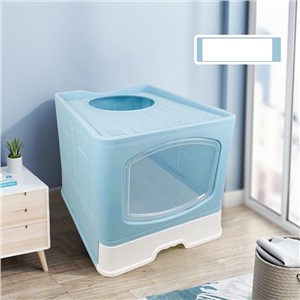
Foldable litter box with lid, enclosed cat toilet, top splash-proof cat toilet for easy cleaning
Read More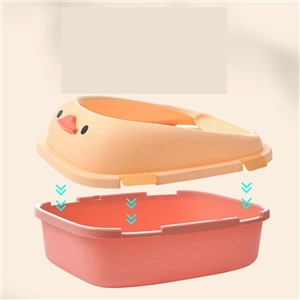
Semi - enclosed top - in litter box anti - splash with large size litter box portable Kitty toilet litter Basin of wholesale
Read More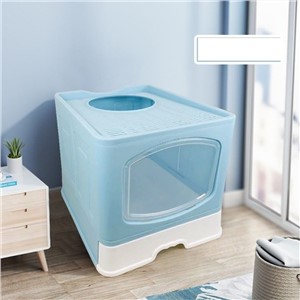
Wholesale increase the full enclosed litter box, drawer drawer drawer type big litter box
Read More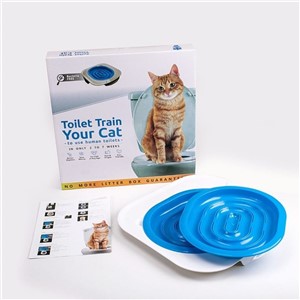
Pet supplies Cat toilet trainer Cat toilet mat can put the cat litter tray stool cushion trainer
Read More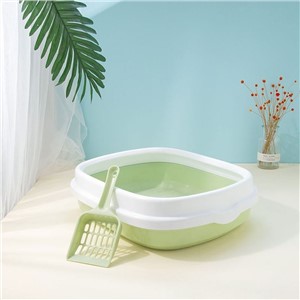
Large thickened semi-enclosed litter box spill-proof cat toilet litter box Pet supplies cat litter box
Read More